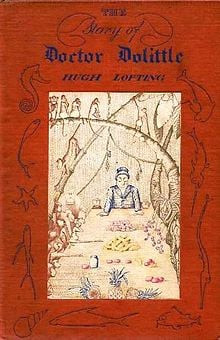Recently, while revisiting a cherished book from my childhood, Hugh Lofting’s The Story of Doctor Dolittle, to read to my four-year-old son, I encountered a jarring disconnect. The initial chapters unfolded with the familiar charm I remembered – a heartwarming, slightly whimsical narrative of a doctor who communicates with animals and heals their ailments. Despite some archaic language, it seemed a timeless story, promising the same delight it once gave me.

However, as Doctor Dolittle journeyed to Africa to aid monkeys afflicted by a deadly epidemic, the narrative took a disturbing turn. His capture by the Jolliginki tribe and subsequent audience with their king revealed deeply problematic illustrations. The depictions of the king and queen – with exaggerated lips and ears, and disproportionate bodies – were clearly caricatures, not characters. The accompanying text echoed this racist portrayal, employing shallow stereotypes indicative of a colonialist perspective, undeniably racist by contemporary standards.
My reading abruptly ceased, replaced by a sense of horror.
My wife’s reaction mirrored my own disgust. While we both were appalled by the depiction of African people, for her, the issue resonated more profoundly as she was born in Ghana, West Africa. As parents to a biracial son with beautiful bronze skin, we are meticulous about curating his reading material, prioritizing books that celebrate diversity and feature children of color.
It was fortunate that I hadn’t read further into The Story of Doctor Dolittle. Following his escape from the Jolliginki, the doctor is recaptured. In a deeply unsettling plot twist, he escapes again with the help of the king’s son, who bizarrely requests to have his skin bleached white to resemble the fairytale princes he admires.
This element was utterly unsuitable for sharing with my son.
I was confronted with my own childhood ignorance, realizing how desensitized I had been to the inherent racism within this narrative. Admittedly, racial dynamics and the history of racism were not concepts I grappled with until adolescence. Many children likely read Doctor Dolittle as a fantastical tale, oblivious to its underlying colonialist framework and prejudiced stereotypes. Without guidance from an informed parent or educator, these harmful elements can easily be overlooked by young readers.
Reflecting on other beloved childhood books for my son, I recognized Doctor Dolittle wasn’t an isolated case. Revisiting the Tintin graphic novels, I noticed similar issues in Hergé’s work. Tintin in the Congo features cartoonish African characters with oversized pink lips perpetually expressing bewilderment, while Tintin in America includes stereotypical portrayals of Native Americans. Even the seemingly innocuous Babar books contain racially insensitive depictions of Black people.
While these books present outdated and offensive worldviews, they are not without potential value. When children encounter negative stereotypes, parents have an opportunity to transform these moments into valuable teaching experiences. Depending on the child’s age and understanding, parents can explain the historical context that fostered these harmful representations, highlighting their origins in ignorance and prejudice, and emphasizing why such depictions are wrong. These discussions can spark crucial conversations and encourage critical thinking long after the book is closed.
Despite our unfinished reading of The Story of Doctor Dolittle, the experience proved insightful. It illuminated my past unawareness and provided a crucial lesson in becoming a more conscious and informed parent moving forward.
